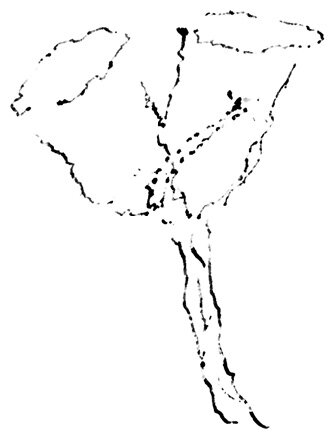From John Colby 27 February 1877
Pantyderi | Blaenffos R.S.O | South Wales
27 Feb 77
Sir
On seeing a review of your book on ‘the Effects of Cross & Self fertilization &c’ in the Spectator1 it struck me that a phenomenon I observed some years ago was explained.
The case I refer to was as follows On the ‘Siebengebirge’ in Germany2 I found a plant (a species of blue bell) on which two blooms were close side by side & joined partly together thus.—3

The conjunction was evidently abnormal but the curious thing I observed was that though both blooms had stamens, only one had a pistil growing within it, & that pistil bent away through an aperture in the bell, where they joined so that rather more than the upper half of it was in the bell which had no proper pistil of its own.
My impression was that there was an effort of nature to make one female portion receive the advantage of all the male portions of both blooms on a kind of economical principle. But now I think the pistil must have taken advantage of the pistil-less condition of the adjoining bell to secure a sort of cross fertilization from it.
I hope the fact may be deemed curious enough to serve as an excuse for troubling you with this letter.
yrs truly | John Colby
Footnotes
Bibliography
Cross and self fertilisation: The effects of cross and self fertilisation in the vegetable kingdom. By Charles Darwin. London: John Murray. 1876.
Summary
Reports a bluebell monster.
Response to Cross and self-fertilisation, reviewed in Spectator.
Letter details
- Letter no.
- DCP-LETT-10872
- From
- John Colby
- To
- Charles Robert Darwin
- Sent from
- Pantyderi
- Source of text
- DAR 161: 207
- Physical description
- ALS 3pp
Please cite as
Darwin Correspondence Project, “Letter no. 10872,” accessed on 19 April 2024, https://www.darwinproject.ac.uk/letter/?docId=letters/DCP-LETT-10872.xml


